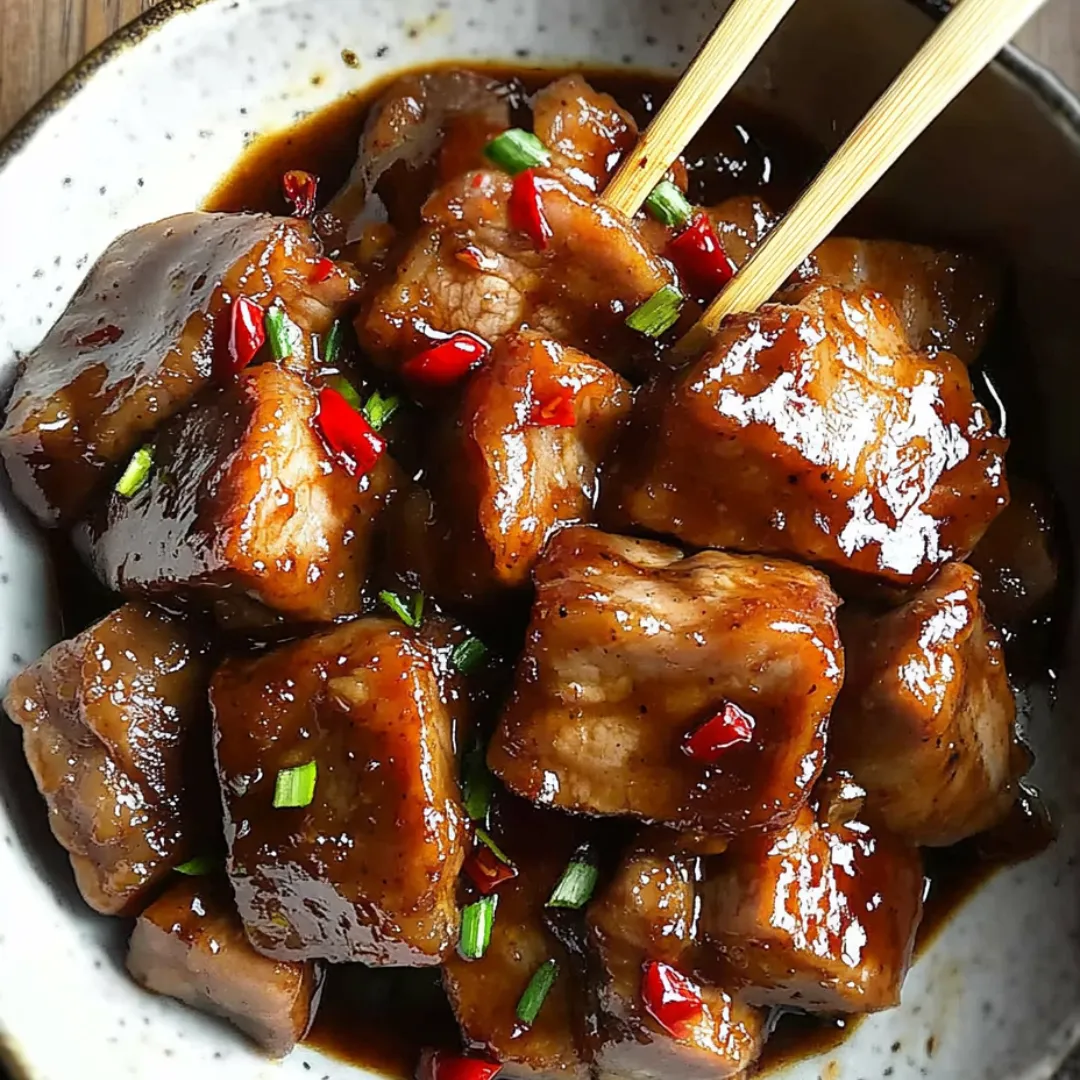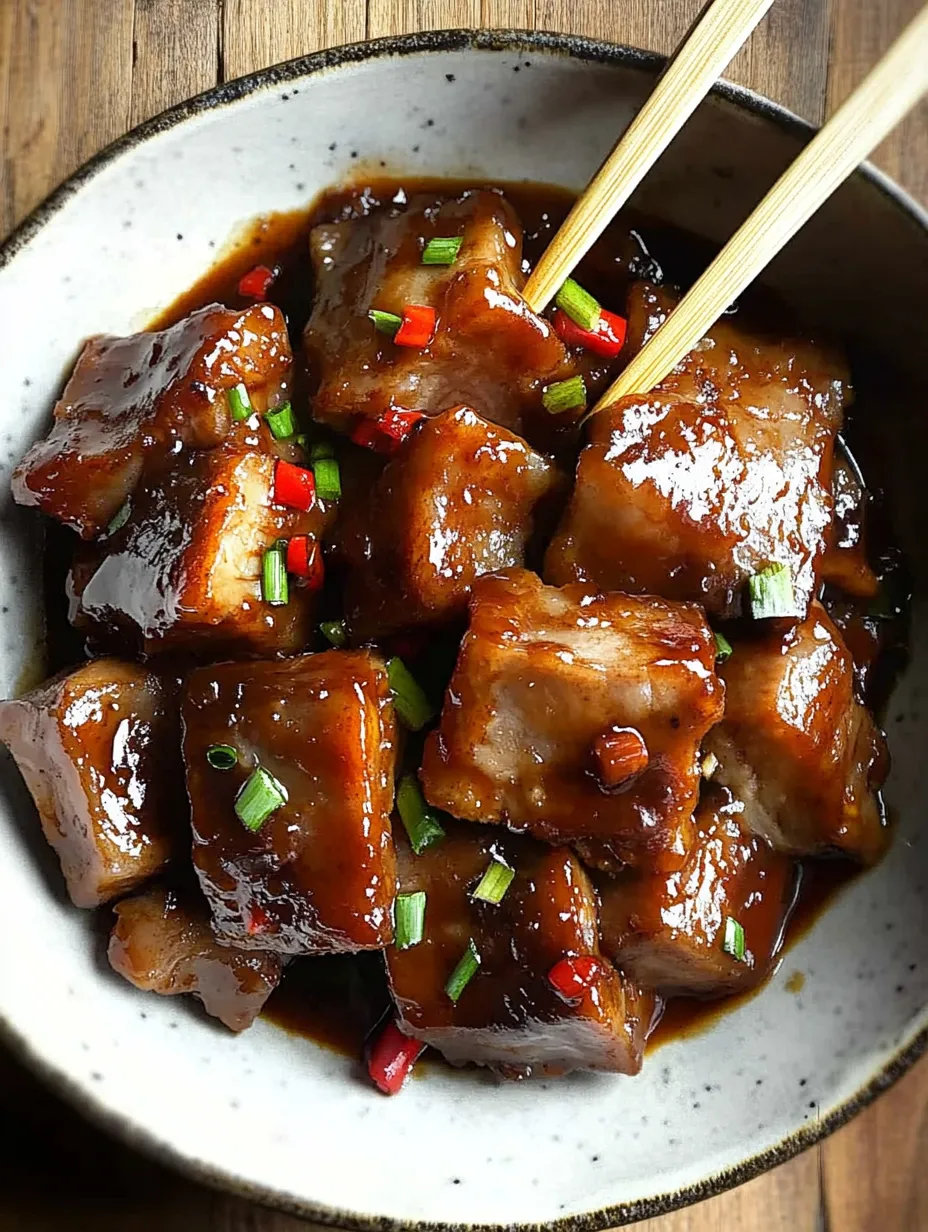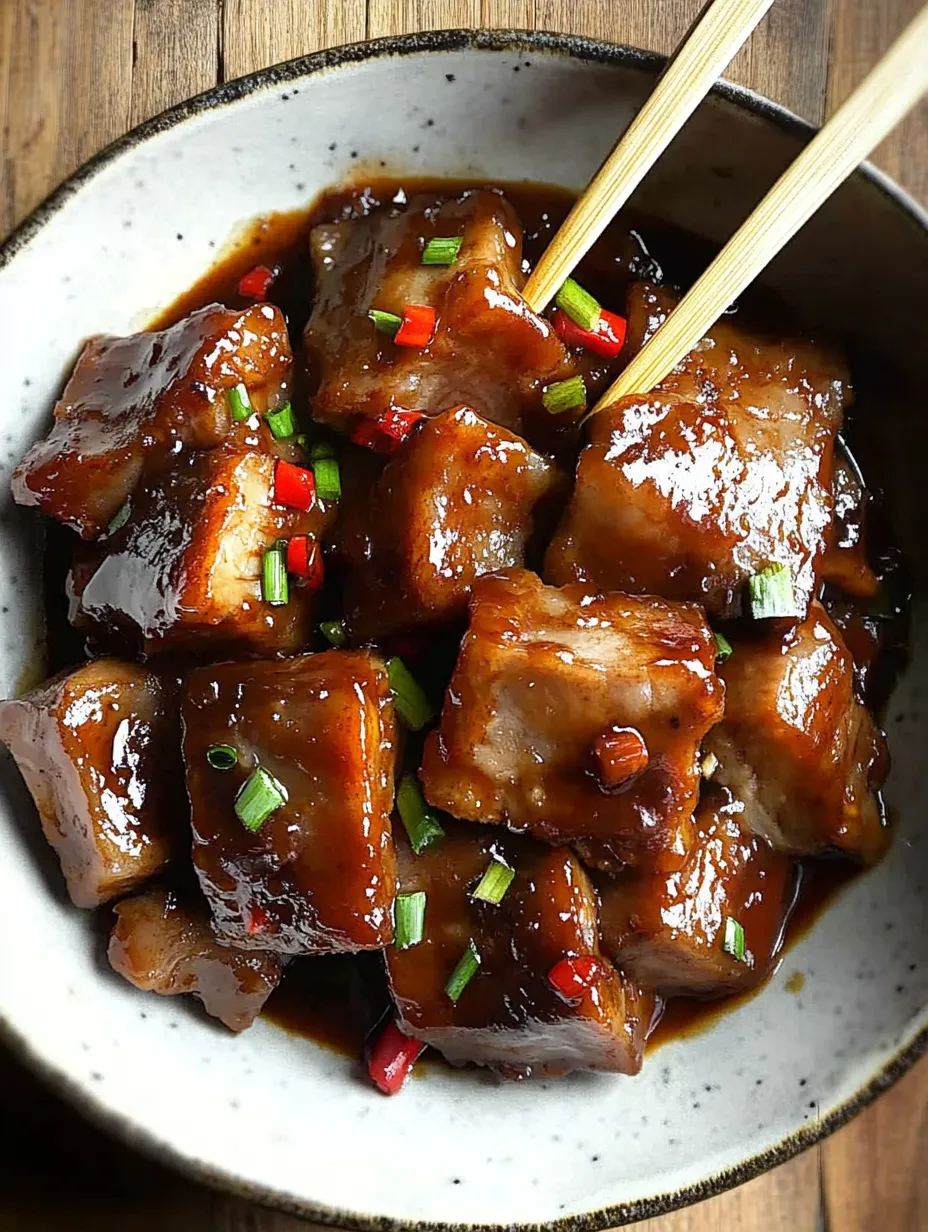 Pin it
Pin it
This sticky hoisin pork belly transforms ordinary meat into an extraordinary meal with minimal effort. The magic happens when the fatty, juicy pork meets the caramelized hoisin sauce, creating layers of flavor that simply can't be achieved any other way. The pork belly's natural richness gets enhanced through a two-step cooking process - first roasting to render the fat and create tender meat, then stir-frying with aromatics to infuse every morsel with savory-sweet goodness. This dish strikes that perfect balance between crispy edges and melt-in-your-mouth centers, making it utterly irresistible when served over a bed of fluffy rice that soaks up all that glossy sauce.
I discovered this cooking technique years ago when trying to recreate my favorite dish from a small family-owned Chinese restaurant. My first attempts were disappointing - either too dry or lacking that distinctive caramelized flavor. One evening, when I was short on time, I used leftover roasted pork belly and quickly stir-fried it with hoisin sauce. The result was magical! The pre-roasted pork absorbed the sauce perfectly while maintaining its juicy texture. My family now requests this dish at least twice a month, and I'm happy to oblige since it's so simple yet impressive.
Ingredients You'll Need
- 1 pound Pork Belly: The star of the show with its perfect ratio of fat to meat. Look for pieces with even layering of fat and meat for the best texture. Fresh pork belly from a butcher will yield better results than packaged options, as you can select pieces with the ideal fat-to-meat ratio
- 2 Red Chili Peppers: Provides that perfect kick of heat that balances the richness. For milder flavor, remove the seeds and membranes, or substitute with red bell pepper for all the color without the spice
- 1 tablespoon Fresh Ginger: Adds a warming, aromatic quality that cuts through the richness. Always use fresh, not powdered, for that distinctive zingy flavor that can't be replicated
- 4 cloves Garlic: Creates the aromatic foundation of the dish. Mince it finely but don't use a press, which can make it bitter. Hand-chopped garlic releases its oils more gradually during cooking
- ¼ cup Hoisin Sauce: This thick, fragrant sauce brings sweet and savory elements together. Look for brands without artificial coloring for the best flavor profile
- 2 tablespoons Low-Sodium Soy Sauce: Adds that essential umami depth. Using low-sodium allows you to control the saltiness and prevents the dish from becoming too salty as it reduces
- 1 tablespoon Rice Vinegar: Provides crucial acidity that balances the sweet hoisin. Don't substitute with white vinegar, which lacks the subtle sweetness unique to rice vinegar
- 2 teaspoons Sesame Oil: Contributes that distinctive nutty aroma that's characteristic of Chinese cooking. A little goes a long way, so measure carefully
- Fresh Cilantro: Brightens the finished dish with herbaceous notes. The stems contain intense flavor, so finely chop and include them in the cooking process
- 2 tablespoons Neutral Oil: For cooking; choose one with a high smoke point like avocado or grapeseed oil to prevent burning during the high-heat stir-fry
 Pin it
Pin it
Step-by-Step Cooking Instructions
- Prepare the Pork Belly:
- Begin by patting your pork belly dry with paper towels to remove excess moisture, which is essential for proper browning. Using a sharp knife, score the fat side in a diamond pattern, cutting just deep enough to reach the meat without slicing through it completely. This scoring helps render the fat and allows the marinade to penetrate deeper. Cut the pork belly into 1-inch cubes, trying to ensure each piece has both meat and fat for the perfect texture contrast. Season generously with salt and pepper, massaging it into the meat to ensure even distribution.
- Initial Roasting Phase:
- Preheat your oven to 375°F (190°C). Arrange the seasoned pork belly pieces in a single layer on a baking sheet lined with parchment paper or aluminum foil for easier cleanup. Make sure to leave a little space between each piece to allow for proper air circulation. Roast for approximately 30-35 minutes, turning the pieces halfway through, until the fat has begun to render and the edges start to crisp up. You'll notice the pieces have shrunk slightly and developed a beautiful golden color. This step can be done up to 24 hours in advance if you're planning ahead.
- Prepare Your Aromatics:
- While the pork is roasting, finely mince the garlic and ginger. For the garlic, smash each clove with the flat side of your knife first to make peeling easier and release more essential oils. Slice your red chili peppers into thin rings, removing the seeds if you prefer less heat. Coarsely chop about 3 tablespoons of fresh cilantro, keeping the stems which contain intense flavor. Having all these aromatics prepared before you start stir-frying ensures the cooking process will go smoothly without anything burning.
- Create Your Sauce Mixture:
- In a small bowl, whisk together the hoisin sauce, soy sauce, rice vinegar, and sesame oil until well combined. This pre-mixing ensures the sauce will incorporate evenly into the stir-fry without any clumps of hoisin sauce. The mixture should have a thick but pourable consistency. If it seems too thick, add a tablespoon of water to loosen it slightly. Taste and adjust the balance of sweet, salty, and acidic elements to your preference.
- Stir-Fry Magic Happens:
- Heat a wok or large skillet over high heat until it's smoking slightly. Add 2 tablespoons of neutral oil and swirl to coat the cooking surface. Quickly add the minced ginger, garlic, and chili peppers, stirring constantly for about 30 seconds until fragrant but not browned. The kitchen will fill with an incredible aroma at this point. Working quickly prevents the garlic from burning, which would introduce bitterness.
- Combine and Caramelize:
- Add the roasted pork belly pieces to the wok with the aromatics. Stir-fry for about 2 minutes to warm the pork throughout and allow it to pick up the flavors of the aromatics. Pour in your prepared sauce mixture and continue stir-frying for 3-4 minutes until the sauce reduces, thickens, and coats each piece of pork with a shiny glaze. You'll notice the sauce turning darker and getting sticky as it caramelizes around the meat. This caramelization is what creates that irresistible flavor.
- Final Touches:
- In the last 30 seconds of cooking, add most of the chopped cilantro, reserving some for garnish. Toss everything together to incorporate the fresh herb flavor. The residual heat will wilt the cilantro slightly while preserving its bright color and fresh taste. Transfer to a serving dish immediately to prevent overcooking. Garnish with the remaining fresh cilantro for a pop of color and fresh flavor contrast.
- Rest and Serve:
- Allow the dish to rest for 2-3 minutes before serving. This brief resting period allows the flavors to settle and the sauce to thicken slightly more. Serve over steamed white rice, which provides the perfect neutral base to soak up all that incredible sauce. For a complete meal, add a side of simply prepared green vegetables like steamed broccoli or bok choy.
My grandfather was a Chinese chef who always insisted that pork belly should never be rushed. He taught me that the patient rendering of fat is what creates that melt-in-your-mouth texture that's impossible to achieve any other way. When I make this dish, I think of him watching over my shoulder, nodding approvingly at the sizzle of the wok and the glossy shine of the sauce. Though my version incorporates some modern shortcuts, I believe he would approve of the result – especially when I see my own children eagerly cleaning their plates just as I did at his table.
The Secret of Proper Pork Belly Selection
Choosing the right cut of pork belly dramatically impacts your final dish. Look for pieces with clear, distinct layers of fat and meat, ideally in roughly equal proportions. Avoid pieces that appear to have mostly fat or mostly meat. The fat should be white or slightly pink, never yellow, which indicates age. If buying from a butcher, ask for center-cut pork belly, which has the most even distribution of fat and meat. For this recipe, skin-off pork belly works best as it allows the flavors to penetrate more effectively and creates better caramelization. However, if you can only find skin-on, don't worry – simply score through the skin deeply or ask your butcher to remove it.
Mastering the Hoisin Balance
Hoisin sauce varies significantly between brands, with some being sweeter, saltier, or thicker than others. After trying numerous brands, I've found that Lee Kum Kee and Kikkoman offer balanced options that work well in this recipe. Whichever brand you choose, taste your sauce mixture before adding it to the pork and adjust accordingly. Too sweet? Add a splash more rice vinegar or soy sauce. Too salty? A teaspoon of honey or brown sugar can help balance it. The perfect hoisin sauce should have a complex flavor with notes of sweetness, saltiness, and a subtle fermented depth that makes you crave more with each bite.
Make-Ahead Strategies
This dish is perfect for meal planning due to its two-stage cooking process. The initial roasting can be done up to three days in advance, with the roasted pork belly stored in an airtight container in the refrigerator. When ready to serve, simply bring the pork to room temperature for 15 minutes, then proceed with the stir-fry steps. This approach actually improves the dish, as the rested pork absorbs the sauce more effectively. You can also prepare the sauce mixture and chop all aromatics a day ahead, storing them separately in the refrigerator. With these components ready, the final dish comes together in literally minutes – perfect for weeknight dinners when time is tight.
Thoughtful Serving Suggestions
While steamed white rice is the classic pairing for this dish, don't limit yourself. Try serving it over noodles tossed with a little sesame oil, or in lettuce cups for a lower-carb option. For a complete meal, consider a side of simply prepared vegetables that complement without competing – garlicky Chinese broccoli, steamed bok choy with a touch of oyster sauce, or even a quick cucumber salad dressed with rice vinegar and a pinch of sugar. The rich pork belly benefits from these fresher, lighter accompaniments that cut through the richness and cleanse the palate between bites.
 Pin it
Pin it
Troubleshooting Common Issues
Even experienced cooks occasionally encounter challenges with pork belly. If your pork isn't crisping properly during the initial roast, try patting it extra dry before cooking and check that your oven temperature is accurate with an oven thermometer. If the sauce becomes too reduced and sticky during stir-frying, add a tablespoon or two of chicken stock or water to loosen it. Conversely, if the sauce remains too thin, continue cooking it down, or mix 1 teaspoon of cornstarch with 1 tablespoon of cold water and stir this slurry into the sauce. Remember that the sauce will thicken slightly as it cools, so remove it from heat just before it reaches your desired consistency.
After years of perfecting this hoisin garlic pork belly recipe, I've come to appreciate how the simplest dishes often create the most profound dining experiences. There's something almost meditative about watching pork belly transform through the cooking process – from raw potential to glistening, caramelized perfection. The time spent tending to it feels less like a chore and more like participating in a culinary tradition that spans generations. Whether you're cooking for a special occasion or simply elevating a weeknight dinner, this dish brings a touch of restaurant luxury to your home table. The balance of sweet, savory, and spicy elements creates a harmonious flavor profile that satisfies on a deeply primal level, reminding us why certain food combinations have endured through centuries of culinary evolution.
Frequently Asked Questions
- → Can I use a different cut of pork?
- Yes, pork shoulder or pork butt can work as alternatives, though they won't have the same fat content that makes pork belly so rich and flavorful. If using leaner cuts, consider marinating overnight and cook for slightly longer at a lower temperature.
- → How do I know when the pork belly is done?
- Pork belly should reach an internal temperature of 165°F (74°C). Visually, the outside should be caramelized and crispy, and the meat should be tender when pierced with a fork. The fat should be rendered and slightly translucent.
- → Can I make this less spicy?
- Absolutely. You can omit the chili pepper entirely or use a milder variety like Anaheim instead of jalapeño or serrano. You could also remove the seeds and membranes, which contain most of the heat.
- → What sides go well with this dish?
- Besides steamed rice, try it with stir-fried vegetables like bok choy or broccoli, a simple cucumber salad, or pickled vegetables to balance the richness. Steamed buns (baos) also make excellent accompaniments.
- → Can I prepare this in advance for a party?
- Yes, you can roast the pork belly ahead of time and keep it refrigerated. When ready to serve, reheat it in a 350°F (175°C) oven until warmed through, then proceed with the sauce steps. Note that reheated pork belly won't be as crispy as freshly made.
